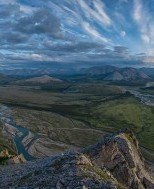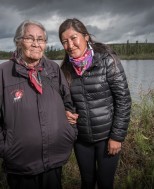FAQs
General FAQs
Q. Is the Peel Watershed protected now that the Supreme Court of Canada case is over?
The Peel is not yet fully protected - we still need to go through final consultations on a Peel Watershed Land Use Plan. This is what should have happened years ago, before the previous Yukon government derailed the land use planning process by introducing its own plan at the last minute. The Yukon government and First Nations have already met to discuss next steps for final consultations, which will be starting soon. Stay tuned for more details about consultations once they are released. We will need your voice for one last push to see this campaign to the end!
Q. What was the difference between the Final Recommended Plan from the Peel Watershed Planning Commission and the previous Yukon Government’s Plan?
The Final Recommended Plan from the Peel Watershed Planning Commission was the culmination of seven years of democratic consultation, with input from governments, industry, other stakeholders and the public. It provides for 55% permanent protection and 25% interim protection of the Peel Watershed (where roads and mining would not be permitted), with the remaining 20% available to development.
The plan adopted by the Yukon Government was developed behind closed doors, without input from the First Nations or the public, and provided for at most 29% protection, with over 71% of the watershed open to development.
Q. Can’t we have both development and protection in the Peel?
The Final Recommended Plan was a compromise and allows for 20% of the region to be open to mining and development. We feel that this is the upper limit of development that can happen in the Peel without severely jeopardizing the ecological integrity of the region, and it was also a compromise for the First Nations, who originally wanted 100% protection. The Peel is a truly special region and one of the few remaining unroaded areas in North America. Once development happens, the effects on the environment cannot be undone. Part of the rationale for protection is leaving choices for future generations.
Q. Would surface access (roads) really affect the Peel?
Yes. For the wildlife that depend on the Peel, roads fragment their habitat and make natural behaviour and survival more difficult. Roads drastically transform the wilderness and are often a gateway to more and more development, resource extraction, and land disturbance. There are endless examples from across Canada and the world of population decline being linked to habitat loss caused by roads.
Q. What is the connection to climate change?
With the North warming up faster than almost anywhere else on Earth, the Peel could be a refuge for species threatened by climate change. As a diverse and intact ecosystem, it could provide conditions that would allow wildlife and biodiversity to adapt to the effects of climate change by moving south to north. This is why the Peel is the northern anchor of the Yellowstone-to-Yukon initiative. Natural landscapes also act as carbon sinks, storing CO2 in trees, soil and permafrost. In short, we need nature to reduce emissions and buffer the impacts of climate change.
Q. But doesn’t the Yukon need more mining to keep the economy strong and provide people with good paying jobs?
Mining is an important part of the Yukon economy, and there are ways that it can be done responsibly, but not all areas of the Yukon should be open to mining, particularly where there are significant ecological and cultural values that would be damaged. The Yukon also has untapped potential in areas of wilderness tourism, and the Peel could be an example of how local communities can benefit from more sustainable and conservation-based economic development.
FAQs about the Supreme Court Case
Q. What was the Supreme Court of Canada ruling?
In a unanimous decision, the highest court in Canada ruled that the Yukon government must complete meaningful final consultations on a land use plan that protects 80% of the pristine watershed. This comes after the Yukon government, under previous leadership, derailed the planning process, forcing through its own agenda to industrialize 71% of the Peel and betraying its constitutional obligations. The ruling sets a precedent for the future of land use planning in the territory, ensuring the integrity of First Nations Final Agreements is upheld and Yukon is working together in the spirit of reconciliation. The court did not rule on the Yukon government’s right to reject a land use plan, but the ruling does provide guidance that limits the Yukon government’s ability to modify or reject a plan at the final stage of the process.
The ruling also sets a precedent for how modern treaties will be interpreted across Canada for decades to come.
Q. Who were the parties on the Peel Watershed legal case?
The appellants on the case were the First Nation of Na Cho Nyäk Dän, the Tr'ondëk Hwëch'in, the Vuntut Gwitchin First Nation, CPAWS Yukon and the Yukon Conservation Society. The Gwich’in Tribal Council and Council of Yukon First Nations intervened in support of our case.
Q. What does it mean for a case to be heard by the Supreme Court of Canada?
The Supreme Court of Canada’s decision to hear our case means that it is of national significance. Very few cases proposed to the Supreme Court of Canada are actually heard (one in ten).
Q. Is the hearing available online?
Yes, you can watch the recording on the Supreme Court of Canada's website by clicking here.
Q: Where can I find a copy of the legal documents?
This Dropbox link contains resources including all the legal documents for the Yukon Supreme Court, Yukon Court of Appeal, and Supreme Court of Canada.






